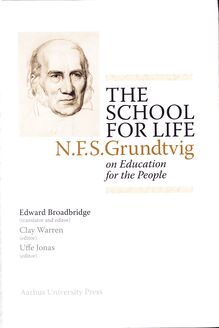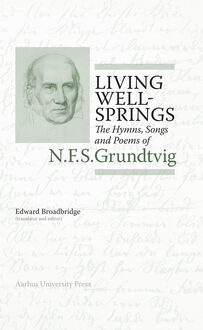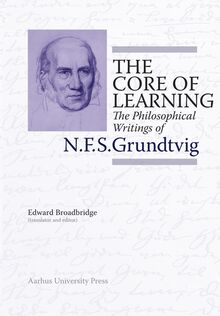-
 Univers
Univers
-
 Ebooks
Ebooks
-
 Livres audio
Livres audio
-
 Presse
Presse
-
 Podcasts
Podcasts
-
 BD
BD
-
 Documents
Documents
-
- Cours
- Révisions
- Ressources pédagogiques
- Sciences de l’éducation
- Manuels scolaires
- Langues
- Travaux de classe
- Annales de BEP
- Etudes supérieures
- Maternelle et primaire
- Fiches de lecture
- Orientation scolaire
- Méthodologie
- Corrigés de devoir
- Annales d’examens et concours
- Annales du bac
- Annales du brevet
- Rapports de stage
La lecture à portée de main
441 pages
English
Découvre YouScribe en t'inscrivant gratuitement
Je m'inscrisDécouvre YouScribe en t'inscrivant gratuitement
Je m'inscris
Obtenez un accès à la bibliothèque pour le consulter en ligne
En savoir plus
En savoir plus
441 pages
English
Obtenez un accès à la bibliothèque pour le consulter en ligne
En savoir plus
En savoir plus

Description
N.F.S. Grundtvig (1783-1872) produced a major body of work in the fields of theology, education, literature, politics, and history. He was also a poet, a hymn-writer, and a translator. In particular, however, it is his educational writings that over the years have attracted international attention from the USA in the west to Japan in the east. In recognition of his influence the European Union called its adult education project the Grundtvig programme. As part of its agenda to digitalise and translate some of this vast output, the Grundtvig Study Centre at the University of Aarhus is pleased to publish this broad selection of Grundtvig's writings on education in a completely new translation. The texts vary in form from poems and songs to articles in periodicals, introductions to books, an open letter to the Norwegians and a private letter to the King of Denmark. These texts, taken together, will provide a solid basis for international scholars without knowledge of Danish to be able to work closely with Grundtvigs ideas on education for the people. The book is accompanied by a CD (MP3 format) with the texts read by Edward Broadbridge and the introductions by Clay Warren.
Sujets
Informations
| Publié par | Aarhus University Press |
| Date de parution | 29 août 2011 |
| Nombre de lectures | 2 |
| EAN13 | 9788771242638 |
| Langue | English |
| Poids de l'ouvrage | 5 Mo |
Informations légales : prix de location à la page 0,1950€. Cette information est donnée uniquement à titre indicatif conformément à la législation en vigueur.
Extrait
THE SCHOOL FOR LIFE N.F.S.Grundtvig on Education for the People
Edward Broadbridge (translator and editor) Clay Warren (editor) Uffe Jonas (editor)
Aarhus University Press
THE SCHOOL FOR LIFE
THE SCHOOL FOR LIFE
N.F.S. Grundtvig on Education for the People
Edward Broadbridge (translator and editor)
Clay Warren (editor) Uffe Jonas (editor)
Opening Essay: Ove Korsgaard Text Introductions: Uffe Jonas Concluding Essay: Clay Warren
Aarhus University Press |
The School for Life: N.F.S. Grundtvig on Education for the People © Aarhus University Press and Edward Broadbridge, Clay Warren, Uffe Jonas, and Ove Korsgaard Linguistic consultant: John Nicholson Illustrations selected and annotated by Ove Korsgaard
Typeset by Narayana Press Cover design by Jørgen Sparre Front cover illustration: P.C. Skovgaard’s drawing of Grundtvig, 1847. Frederiksborg Castle. The handwriting is Grundtvig’s own. It includes the famous lines: “Freedom for Loki as well as for Thor”. The Royal Library, NKS 3927, 4°, f. 5r. Courtesy of The Royal Library, Copenhagen.
Ebook production: Narayana Press
ISBN 978 87 7124 263 8
Aarhus University Press Aarhus Langelandsgade 177 DK – 8200 Aarhus N
København Tuborgvej 164 DK – 2400 København NV www.unipress.dk
INTERNATIONAL DISTRIBUTORS: Gazelle Book Services Ltd. White Cross Mills Hightown, Lancaster, LA1 4XS United Kingdom www.gazellebookservices.co.uk
The David Brown Book Company Box 511 Oakville, CT 06779 USA www.oxbowbooks.com
T H I S P A G E I S P R O T E C T E D B Y C O P Y R I G H T A N D M A Y N O T B E R E D I S T R I B U T E D
Illustrations ·6 Foreword ·7 Notes on contributors ·11
Contents
Grundtvig’s Philosophy of Enlightenment and Education Ove Korsgaard ·13
1 The University in London and the Academy at Sorø (1827‑28) ·36 2 Nordic Mythology – extract (1832) ·42 3 Education for the State (1834) ·76 4 Is Faith Truly a School Matter? (1836) ·121 5 The Danish Four‑leaf Clover or A Partiality for Danishness (1836) ·126 6 A Roman Song (1837) ·166 7 To the Norwegians concerning a Norwegian High School (1837) ·173 8 The School for Life and the Academy in Sorø (1838) ·187 9 On the Union of Learning in the North (1839) ·224 10 Enlightenment (1839) ·252 11 Open Letter to My Children (1839) ·257 12 Appeal for, and Concept of, a Danish High School in Sorø (1840) ·266 13 Free School Song (1841) ·289 14 On the Establishment of Sorø Academy as a People’s High School (1843) ·292 15 A Congratulation to Denmark on the Danish Dimwit and the Danish High School (1847) ·300 16 Response from Grundtvig toOn His High School and the ‘Danish Society’(1854) ·345
The International Reception of N.F.S. Grundtvig’s Educational Ideas Clay Warren ·352
Notes ·370 Timeline ·417 Select Bibliography ·420 Indexes ·429
[ 5]
T H I S P A G E I S P R O T E C T E D B Y C O P Y R I G H T A N D M A Y N O T B E R E D I S T R I B U T E D
1.
2.
3. 4. 5. 6.
7.
8. 9.
10.
11. 12.
T H E S C H O O L F O R L I F E
Illustrations
People’s march to the King, 21 March 1848, with Grundtvig at the upper window, Frederiksborg Castle Nordic Mythology, The Royal Library, NKS 3927, 4°, f. 5r. Courtesy of The Royal Library, Copenhagen, Denmark Portrait 1820 by C.F. Christensen, Frederiksborg Castle Drawing 1844 by J. Vilhelm Gertner, Vartov. Photo by Poul Pedersen Sorø Academy, drawing by Just Michael Hansen, 1857 Grundtvig lectures at Borch’s hall of residence. Drawing by Johan ThomasLundbye, 1841, Frederiksborg Castle Open Letter to My Children, The Royal Library, The Grundtvig Archives, fascicule 348, f. 1r. Courtesy of The Royal Library, Copenhagen, Denmark Pencil drawing 1847 by P.C. Skovgaard, Frederiksborg Castle The Constitutional Assembly, painting by Constantin Hansen, 1860‑64, Frederiksborg Castle ‘A Lecture in the Dagmar Room at Askov People’s High School’, painting by Erik Henningsen, 1903, 66,5 x 88 cm, RKMm0072, Ribe Art Museum. © photo, Ribe Art Museum Photograph of Grundtvig 1872 by Adam Lønborg. Photo by Poul Pedersen Udby Church, unknown artist
[6]
Foreword
N.F.S. Grundtvig (17831872)produced a major body of work in the fields of theo‑ logy, education, literature, politics, and history. He was also a poet, a hymn‑writer, and a translator. In particular, however, it is his educational writings that over the years have attracted international attention – from the USA in the west to Japan in the east. In recognition of his influence the European Union called its adult education project ‘the Grundtvig programme’. As part of its agenda to digitalise and translate some of Grundtvig’s vast output, the Grundtvig Study Centre at the University of Aarhus is pleased to publish this broad selection of Grundtvig’s writings on education in a completely new translation. The representative selections have been taken from the standard collection of Grundtvig’s writings on education,Grundtvigs Skoleverden(1968) by Professor K.E. Bugge. They vary in form from poems and songs to articles in periodicals, introductions to books, an open letter to the Norwegians, and a private letter to the King of Denmark. Our hope is that taken together they will provide a solid basis for international scholars without knowledge of Danish to be able to work closely with Grundtvig’s ideas on education for the people. To set Grundtvig’s ideas in their historical context, Professor Ove Korsgaard of the Danish School of Education, University of Aarhus, has provided a lengthy introduc‑ tion, while postdoctoral researcher Uffe Jonas introduces each text into its immediate context. Finally, an essay by Professor Clay Warren, The George Washington University, discusses the international reception of Grundtvig’s ideas with special emphasis on adult education in the USA. A timeline, a bibliography of works in English, a few selected illustrations, and a comprehensive index provide readers with a scholarly basis on which to build.
The Grundtvig Study Centre at Aarhus University was established on 1 January 2009 to continue the work of the former Centre for Grundtvig Studies, which was established in 1988.
[ 7]
O N T E N T S C T H I S P A G E I S P R O T E C T E D B Y C O P Y R I G H T A N D M A Y N O T B E R E D I S T R I B U T E D
T H E S C H O O L F O R L I F E
The work of the Grundtvig Study Centre is focused on the following areas:
1. An annotated digital edition of Grundtvig’s writings 2. Research in areas of specific interest to Grundtvig: •Theology and the church •Democracy and the concept offolkelighed(the people’s character) •ideas and the concept of Educational folkeoplysning(popular education/enlight‑ enment) 3. Knowledge exchange, teaching, and communication
Edward Broadbridge has translated and edited the texts from the original Danish, assisted by John Nicholson as language consultant. Both have lived and worked in Denmark for 40 years. Uffe Jonas has checked the translations and contributed with specialist knowledge, as well as writing contextual introductions. Finally, Clay Warren has read the manuscript through from an international perspective and contributed most constructively to the end result.
The publication has been supported financially by a number of foundations. The Grundtvig Study Centre, University of Aarhus, wishes to thank the following:
Aarhus Universitets Forskningsfond Konsul George Jorck & Hustru Emma Jorcks Fond N.F.S. Grundtvigs Fond Grundtvigs Forum Sparekassen Kronjylland Dansk Friskoleforening Pastor Niels Møgelvangs Litteraturfond Carlsen‑Langes Legatstiftelse
Michael Schelde, Director of the Grundtvig Study Centre, Aarhus University
T r à n s l à t o r ’ s n o t e
Although Grundtvig is among the most influential of Danes, his work is relatively difficult to comprehend for the modern reader. The total number of his known texts is 1,475, running to 35,000 pages. Almost all of his prose sentences are between 100‑150 words, his syntax is convoluted, his language often obscure, and his numerous refer‑ ences go largely unheeded nowadays. For this reason most of his works are rarely read,
[8]
C O N T E N T S T H I S P A G E I S P R O T E C T E D B Y C O P Y R I G H T A N D M A Y N O T B E R E D I S T R I B U T E D
F O R E w O R d
even in Danish, and when they are, it is mainly at graduate level and beyond. On the other hand, his hymns and songs are widely known and sung, and deeply respected. Grundtvig has proved so difficult to translate that apart from a few songs and hymns, there has so far been little available to English readers. A previous attempt to translate extracts from several of his works and publish them in a single volume was made in 1984 by the present translator in collaboration with N.L. Jensen inA Grundtvig Anthology(James Clarke/Centrum). There have been a number of good biographies be‑ fore Sid Bradley published a translation of Grundtvig’s memoirs coupled with memoirs of others about Grundtvig inN.F.S. Grundtvig: A Life Recalled(Aarhus University Press 2008). The present translation of Grundtvig’s educational ideas takes as its starting point the 2‑volume Danish edition by Professor K.E. Bugge,Grundtvigs Skoleverden(lit. Grundtvig’s School World, Gad 1968). I endeavour not to replicate the difficulty of the original texts but to render them into modern British English for both the scholar and the interested reader. At the same time I have sought to retain their power and originality – as well as the flavour of the times in which Grundtvig lived. In the translation process crucial choices have had to be made, some of which break with a century‑old tradition. Grundtvig is famous for providing the impetus for the ‘folk high school’, but the folk in question are in fact thepeopleof Denmark, and so, after conferring widely, I have chosen ‘People’s High School’ for this translation. In certain quotations, however, ‘folk high school’ is retained. Similarly, the Danish wordoplysningcan be translated variously as enlightenment, education, illumination, or information, so one choice of necessity excludes the others, although it may very well contain their meaning. Despite his complicated syntax Grundtvig’s style is in fact lively, scattered with wit, and often emphasised by italics. I have attempted to emulate all of these characteris‑ tics while using fewer italics and more exclamation marks. These will be clearly heard in the CD reading that accompanies this book. In only a single case have I followed Grundtvig’s Danish simile where an equivalent English one exists, namely, in prefer‑ ring ‘clear as sunlight’ to ‘clear as daylight’. One other word requires a comment here: ‘fatherland’. English‑speaking countries are historically less acquainted with this concept than, say, French or German speak‑ ers. “Allons, enfants, de lapatrie,” sing the French, while Americans are increasingly speaking of their ‘homeland’, never their ‘fatherland’. Grundtvig’s use of ‘fatherland’ should be seen and felt as it is experienced in the Welsh national song, Land of My Fathers. It contains no nationalistic overtones of animosity towards any other nation, but is rather a rallying‑call to Grundtvig’s own people and a complement to his use of mother-tongue. The phrase “in Grundtvig’s fatherland” is still in regular use in Denmark when appealing to his concept of ‘freedom for all’.
[ 9]
C O N T E N T S T H I S P A G E I S P R O T E C T E D B Y C O P Y R I G H T A N D M A Y N O T B E R E D I S T R I B U T E D
-
 Univers
Univers
-
 Ebooks
Ebooks
-
 Livres audio
Livres audio
-
 Presse
Presse
-
 Podcasts
Podcasts
-
 BD
BD
-
 Documents
Documents
-
Jeunesse
-
Littérature
-
Ressources professionnelles
-
Santé et bien-être
-
Savoirs
-
Education
-
Loisirs et hobbies
-
Art, musique et cinéma
-
Actualité et débat de société
-
Jeunesse
-
Littérature
-
Ressources professionnelles
-
Santé et bien-être
-
Savoirs
-
Education
-
Loisirs et hobbies
-
Art, musique et cinéma
-
Actualité et débat de société
-
Actualités
-
Lifestyle
-
Presse jeunesse
-
Presse professionnelle
-
Pratique
-
Presse sportive
-
Presse internationale
-
Culture & Médias
-
Action et Aventures
-
Science-fiction et Fantasy
-
Société
-
Jeunesse
-
Littérature
-
Ressources professionnelles
-
Santé et bien-être
-
Savoirs
-
Education
-
Loisirs et hobbies
-
Art, musique et cinéma
-
Actualité et débat de société
- Cours
- Révisions
- Ressources pédagogiques
- Sciences de l’éducation
- Manuels scolaires
- Langues
- Travaux de classe
- Annales de BEP
- Etudes supérieures
- Maternelle et primaire
- Fiches de lecture
- Orientation scolaire
- Méthodologie
- Corrigés de devoir
- Annales d’examens et concours
- Annales du bac
- Annales du brevet
- Rapports de stage
Signaler un problème
YouScribe
Le catalogue
Le service
© 2010-2024 YouScribe









